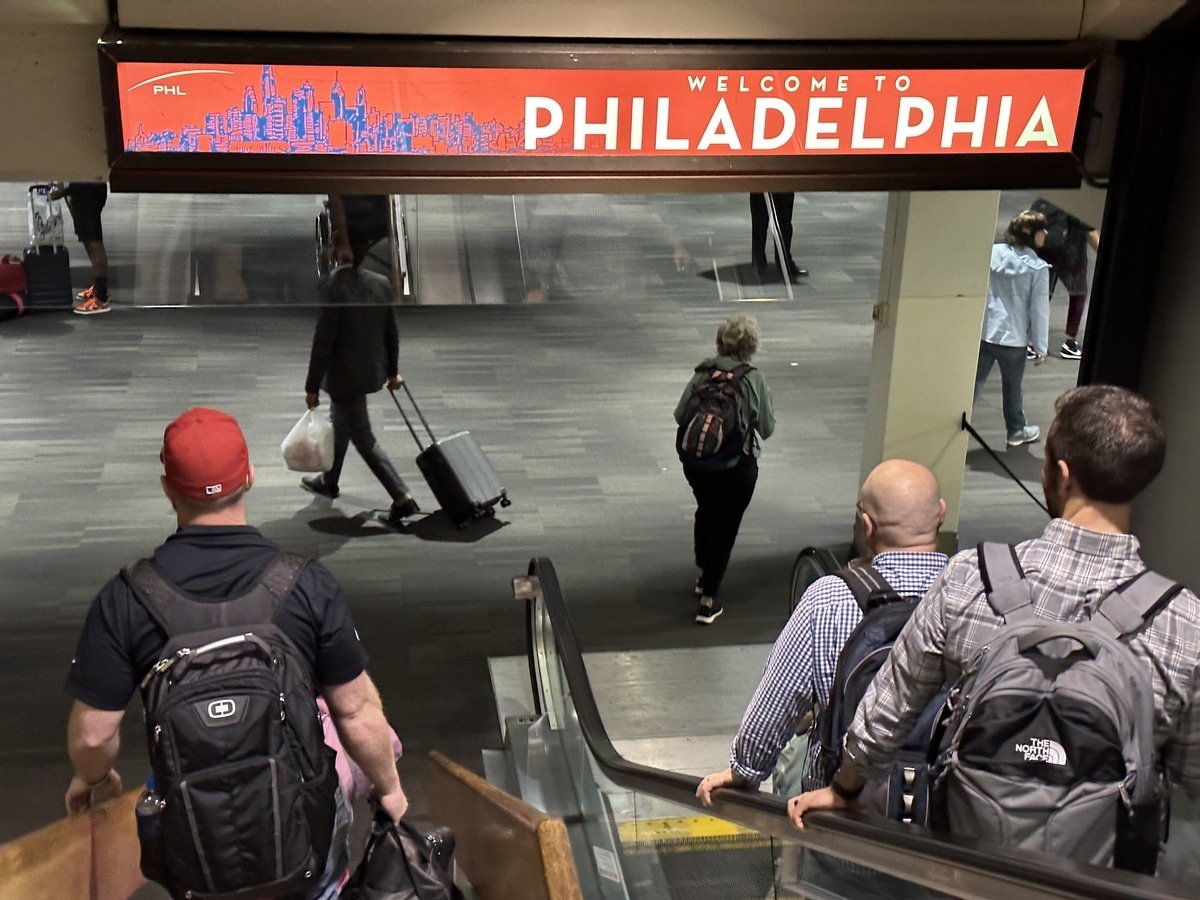This post contains references to products from one or more of our advertisers. We may receive compensation when you click on links to those products. For an explanation of our Advertising Disclosure, visit this page.
If you’re at risk of blood clots or post-flight swelling in your legs and feet, you may already be traveling with compression socks. These specially-designed socks can encourage circulation and can cost less than $20. But did you know that compression socks can also help provide energy and are recommended if you will traveling for more than four hours? Also, there are three different types of socks meant for different people. Here are the reasons to wear (or not wear) compression socks when flying or traveling by car.
Disclaimer: The author is not a medical professional, and you should consult your physician or family doctor for personalized guidance.

What Are Compression Socks?
Compression socks are designed to stop just below your knee and apply more pressure than traditional knee-high socks. This extra pressure can improve circulation when you’re sedentary for extended periods of time, such as on a long-haul flight or a road trip.
You can purchase non-prescription compression socks at many retailers and pharmacies, including Amazon. They typically cost from $8 to $20 per pair, although specialty designs retail closer to $40.
There are three different types of compression stocks available for purchase:
- Nonmedical support hosiery: These are mild compression socks that don’t require a medical prescription. They provide the same amount of compression through the entire area.
- Graduated compression socks: These socks offer the most compression at the ankles and less at the knees. A professional fitting and a prescription are usually necessary.
- Anti-embolism stockings: This variety is only available by prescription and offer graduated compression from the ankles upwards. These stockings are generally intended for the immobile and can require a professional fitting.
In most instances, the nonmedical support hosiery is the most common type of sock that you can buy over the counter from your preferred retailer or pharmacy. They can also be the best overall as they don’t require a professional fitting and provide equal compression from your ankles to your knees. And they come in a variety of colors and patterns, so you can match them with your style.
Consulting with your doctor can help you decide if you should wear these socks when traveling. If so, you can decide which type is best and the best practices for usage.
Benefits of Compression Socks
The two best benefits of wearing compression socks are improved circulation and reduced swelling. You don’t need to have a specific medical condition to wear them.
When To Wear Compression Socks
Wearing compression traveling socks is an excellent idea in these situations:
- You’re at risk of blood clots or deep vein thrombosis (DVT)
- Your feet and legs typically swell after travel or being sedentary
- Recently had surgery on varicose veins
- Have a previous history of blood clots or chronic venous insufficiency
When worn properly, the socks can improve circulation and prevent pain and other negative symptoms. They also won’t hurt your skin or the underlying tissue.
The CDC reports that people are more at risk of blood clots when traveling for at least four hours. Consider wearing these socks for long-distance flights and car trips.
When To Avoid Compression Socks
There are several situations when travel compression socks can do more harm than good:
- Your skin easily bruises or breaks
- The socks cause chafing or sores
- You have diabetes or peripheral artery disease (according to this AARP report)
- Excessive compressions cause a lack of circulation
You may also avoid wearing these socks for short trips, as the benefits can be marginal if your socks cause discomfort or are difficult to put on.
How Long To Wear Compression Socks When Traveling
Putting your socks on as early in the day as possible prevents the probability of fighting with swollen legs. It’s possible to wear them all day, from when you get out of bed until bedtime. However, according to the UK NHS, you shouldn’t wear them while you sleep.
If you’re waiting to put on your socks later in the day, you may need to lie flat for 15 minutes to reduce any present swelling.
Additionally, it’s not uncommon to wait to put them on right before boarding a plane or hopping into the car, as wearing them for an extended period can result in a loss of circulation. However, you must factor in if there will be an area (and time) to put them on.
Tips For Traveling With Compression Socks
Whether or not you wear compression socks when traveling, these suggestions can help encourage circulation and prevent post-travel discomfort.
Walk Regularly
Movement is good for the body and can make compression socks more effective. Try to walk at least once an hour up and down the airplane aisle. If you’re riding in a car, strive to pull over every few hours to walk and stretch. When sitting, try performing basic stretches periodically.
Be The Driver Instead Of The Passenger
Driving gives you a reason to move your legs as you’re continually switching between the gas and brake pedals. Car passengers are more likely to experience discomfort as they can be in one position for longer. However, depending on the vehicle, passengers can have more leg room to stretch and adjust their posture between stops.
Drink Water
Being properly hydrated and drinking water regularly can prevent several health issues. Studies suggest that warm water can even improve blood flow and prevent cramps.
Avoid Sleeping When Traveling
A short nap is alright, but you should try to avoid sleeping for excessive periods as your body remains in the same position for a long time. This can be an issue if you take sleep sedatives while traveling.
Bring Multiple Pairs Of Socks
Packing several pairs of socks can be helpful to wear as you’re sightseeing or if you have multiple travel days. The nonmedical support hosiery can fight swelling and discomfort when you walk extended distances so that you may have more endurance.
Wear Before Traveling
If this is your first time wearing compression socks, consider wearing them for several short periods before hitting the road. It can take time to adapt to the compression feeling. Plus, it will help you know how to wear them and not cause discomfort.
One of the worst situations can be wearing your socks for the very first time on a travel day and being in pain while you’re in the airport or confined to your seat and can’t easily remove them.
Related: Traveling with Disabilities and Special Needs Guide
Summary
Compression socks help many who travel by plane and car avoid pain, swelling, and other health risks. They can be an essential item on your packing list for long trips, but you should consult with your doctor if you have a unique medical situation to verify whether these traveling socks can help.
Related Articles:







